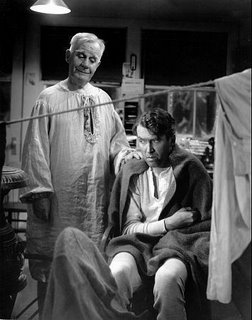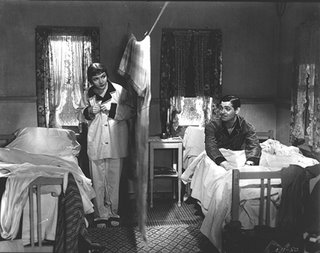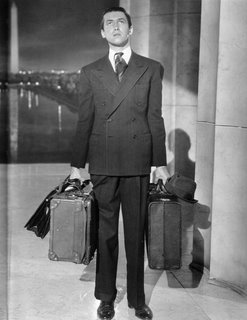
As the final scene of It’s A Wonderful Life (1946) flickers across our collective television screens each holiday season, the overriding message of its director, that “no man is a failure who has friends” seems at once to embody not only the character of every-man George Bailey (James Stewart) but Frank Capra himself. It is that intangible faith and providence imbued in the spirited presence of Frank Capra, as a benevolent, hard-working man about town and who had many friends amongst the Hollywood community, that saw Capra through nearly five decades of film-making and some of the darkest, most ambitious moments of his personal life.
One of the most extraordinary directors of Hollywood’s golden age had one of the most inauspicious beginnings in film folklore. Capra was born on May 18, 1897 in Bisacquino, Sicily. Derived from Italian parentage, Capra and his family immigrated to the United States in 1903 with the promise of
 the American dream firmly secured in their hearts; first in New York, then on June 3, 1903 onto Los Angeles. Capra’s youth was spent mastering the English language and studying at Castelar and Griffin Elementary Schools. To help support his family he sold newspapers. He was a committed youth, as far as youth’s commitments go, and innately aware that his path in life was unlike that envisioned for him by his parents.
the American dream firmly secured in their hearts; first in New York, then on June 3, 1903 onto Los Angeles. Capra’s youth was spent mastering the English language and studying at Castelar and Griffin Elementary Schools. To help support his family he sold newspapers. He was a committed youth, as far as youth’s commitments go, and innately aware that his path in life was unlike that envisioned for him by his parents.More than anything, Capra wanted to learn. Musically inclined, Capra moonlighted as part of a two-man combo that played the red light district. But it was a stint in chemical engineering at Throop College of Technology that first introduced Capra to his new love - poetry. For a moment his life seemed idyllic. The moment, however, did not last.
In 1916 Capra’s father, Turiddu died. The following year, World War I intervened. Despite these setbacks, Capra
 graduated from Throop. His near enlistment in the armed forces was derailed by a virulent bout of Spanish influenza; an unhappy circumstance that resulted in happy chance.
graduated from Throop. His near enlistment in the armed forces was derailed by a virulent bout of Spanish influenza; an unhappy circumstance that resulted in happy chance.While convalescing, Capra heard that director John Ford was looking for extras for his latest film, The Outcasts of Poker Flat (1919). But although he was hired by Ford, extra work did not pay his bills. So Capra assumed the jack of all trades, master of none; toiling as a ditch digger, running errands, freelancing short stories and doing odd jobs of every shape and size. Most of the time, however, he remained unemployed.
Undaunted by his lack of success, together with W. M. Plank, Capra ambitiously incorporated the Tri-State Motion Picture Company in Nevada, producing three short films in 1920 that he also co-wrote. None were enough to sustain the company and once again Capra returned to Los Angeles with his tail tucked between his legs. By March of that same year, he had accepted work for CBC Film Sales Company (later, Columbia Films Studios); a struggling hand-to-mouth operation in which every member was expected to contribute to a variety of tasks. A quick study, Capra learned the rudiments of editing and directing during this tenure. Still, success eluded him.

In 1921 Capra was hired at seventy-five dollars a week by Walter Montague to direct Fulta Fisher's Boarding House. Modestly budgeted at $1700, the film’s $3,500 gross convinced Montague of Capra’s talents. But a minor rift in their early partnership once again sent Capra’s career into a tail spin. It was not until Capra, working as an editor in 1923, met and married Helen Howell that the tide of his folly began to slowly turn.
A move to Hollywood gave Capra his first real job at a real studio, writing gags for Hal Roach’s Our Gang series. Disinterested with this assignment, Capra next went to Mack Sennett Studios and absorbed the opportunity to work on material for comedian Harry Langdon. Langdon was so impressed with Capra’s efforts he hired him to direct The Strong Man.
However, by October of 1927, CBC had become Columbia Pictures – a burgeoning, if struggling, new film studio. Unlike its rivals, Columbia Pictures had no roster of contract talent. Quite simply, they could not afford to invest in a star system the way MGM did. Rather, Production Chief Harry Cohn borrowed his talent from an ever expanding pool of freelance artists that included such luminaries as Irene Dunne, Cary Grant and Katherine Hepburn. Although quickly hired by this tyrannical mogul, Capra was almost as quickly fired after Cohn viewed the early dailies from Capra’s first assignment at the studio, That Certain Thing (1927) and judged them disastrous.
Despite this quiet early animosity brewing between them, Capra continued to work for Cohn – steadily gaining in prestige with each subsequent project. Capra’s early and close association with screenwriter Robert Riskin and cameraman Joseph Walker had begun to develop a distinct style for the studio that was both lightheartedly inspirational and humanitarian.

What Harry Cohn really wanted and needed at this particular point in his studio’s history was a mega hit to fill his coffers and mark the official debut of Columbia as a force to be reckoned with. That zeitgeist that everyone had hoped for was It Happened One Night (1934) – a classic screwball comedy affectionately discounted at its inception by Cohn as ‘a road picture.’ But for once, fate was on Capra’s side.
A tiff between Clark Gable and his alma mater, MGM had resulted in Gable being loaned to Columbia for the project as punishment. Claudette Colbert, a temperamental rising star in her own right, emphatically refused to make the film at first. She was strong-armed by Harry Cohn into complying, openly chastised her forced labor to anyone who would listen – including gossip columnist Hedda Hopper, and quite easily and openly despised Capra, whom she deemed complicit in her entrapment. At the end of her last day of shooting, Colbert telephoned a friend to say that she had “just completed the worst picture of (her) life!”

But the proof was in the can. Upon its premiere, It Happened One Night was an instant and colossal financial and critical success, winning in all four key Oscar categories: Best Actor (Gable), Actress (Colbert), Director (the first of three statuettes for Capra) and Best Picture. Awash in the overnight sensation of instant fame, Capra could now write his own ticket. He directed the effervescent Mr. Deeds Goes to Town (1936), the controversial Mr. Smith Goes To Washington (1939) and the lighthearted caper, Arsenic and Old Lace (1941).
But by far, Capra and Columbia’s most ambitious collaborative effort to date was the epically mounted, Lost Horizon (1937).
No comments:
Post a Comment